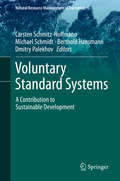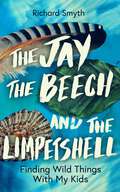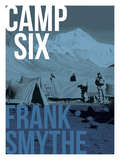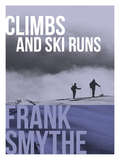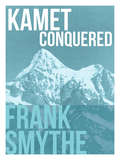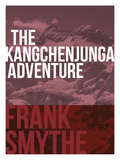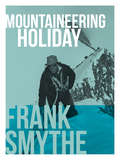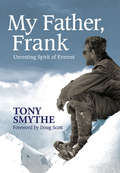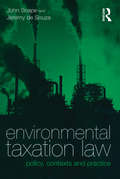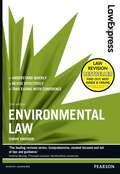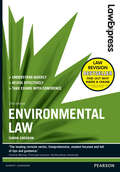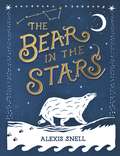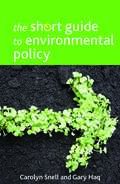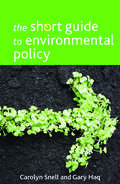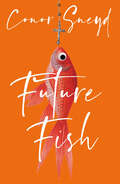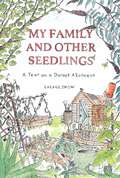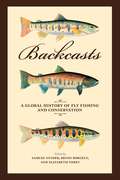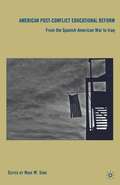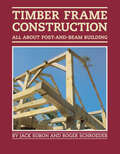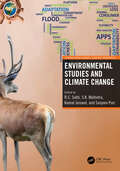- Table View
- List View
Voluntary Standard Systems: A Contribution to Sustainable Development (Natural Resource Management in Transition #1)
by David M. SmythEmerging to the forefront of sustainable production and consumption are a promising and rapidly evolving concept known as Voluntary Standard Systems (VSS). They encompass the three pillars of sustainability – social, environmental and economic aspects and consequently they can be considered as a tool, which makes sustainable development visible. Currently, they are becoming a significant element in international trade and in the promotion of sustainable development strategies, especially in the context of globalised markets and supply chains.This volume provides a comprehensive overview of the current VSS concepts: from their nature and functioning, to the future outlook for their development. It places VSS in the broader context of global development issues and challenges, including development policy and international sustainability commitments, progress towards achieving ‘green economy’ and meeting climate protection targets. The volume contains also a representative selection of case studies which demonstrate their wide range of application in different sectors of the economy.
The Jay, The Beech and the Limpetshell: Finding Wild Things With My Kids
by Richard Smyth'Generous, moving and alive. A gift' - Tim Dee, author of Greenery'Intelligent, thought-provoking and always, always interesting' - Cal Flyn, author of Islands of Abandonment'Smyth writes with warmth and engaging perception about our relationship and understanding of the natural world on our doorsteps' - Jon Dunn, author of The Glitter in the Green'Fresh and tender and playful' - Patrick Galbraith, author of In Search of One Last SongWeren't they richer, rock pools, wasn't the seashore busier, when I was a kid?Richard Smyth had always been drawn to the natural world, but when he became a father he found a new joy and a new urgency in showing his kids the everyday wild things around them. As he and his children explore rockpools in Whitley Bay, or the woods and moors near his Yorkshire home, he imagines the world they might inhabit as they grow up. Through different objects discovered on their wanderings - a beech leaf, a jay feather, a limpetshell - Smyth examines his own past as well as that of the early natural historians, weaving together history, memoir, and environmentalism to form a new kind of nature writing: one that asks both what we have lost, and what we have yet to find.
Camp Six: The 1933 Everest Expedition
by Frank SmytheFrank Smythe's Camp Six is one of the greatest Everest accounts ever written. It is the story of the 1933 Everest Expedition, in which Smythe, climbing alone after his partner Eric Shipton had turned back ill, reached a point perhaps higher than any man had done before - and some twenty years before the eventual first ascent. Rope-less, oxygen free and in terrible snow conditions, his climb was one of the greatest endeavours in the history of Everest. Camp Six is a compelling read: a gripping adventure on the highest mountain in the world and a fascinating window into early mountaineering and Himalayan exploration - including an illuminating colonial view of early travels in Tibet. It is essential reading for all those interested in Everest and in the danger and drama of those early expeditions. Frank Smythe was one of the leading mountaineers of the twentieth century, an outstanding climber who, in his short life - he died aged forty-nine -was at the centre of high-altitude mountaineering development in its early years. Author of twenty-seven immensely popular books, he was an early example of the climber as celebrity.
Climbs and Ski Runs
by Frank Smythe"Why do you climb?" The mountaineer has no answer to this question. The best things in the world cannot adequately be expressed in speech or print; they are part of the soul.' In Climbs and Ski Runs, Frank Smythe takes the reader on Alpine ski trips and Dolomite adventures, up first ascents in North Wales and on to the mighty Brenva Face of Mont Blanc. He places pebbles for runners, 'shoots' crevasses and is struck by lightning. And yet, all the while, he perfectly captures the moments that make climbing and mountaineering so special - moments that will resonate with anybody who has spent time in the hills. Frank Smythe was among the leading mountaineers of the early twentieth century and one of the finest climbing writers ever to put pen to paper. In Climbs and Ski Runs he documents his early forays into the mountains, giving a remarkable insight into that period of climbing and mountaineering. Yet it is not this that makes the book special. It is Smythe's ability to observe and recreate his surroundings and to write so compellingly about the climber's response to them, and to the moments of difficulty and danger, that brings Climbs and Ski Runs to life.
Kamet Conquered: The historic first ascent of a Himalayan giant
by Frank SmytheFrank Smythe’s fascinating book Kamet Conquered tells of his successful bid to make the first ascent of Kamet (7,756 metres) in 1931. Through Smythe, an experienced high-altitude mountaineer, the reader experiences all the tension, fatigue, discomfort and struggle of a major expedition but is also able to enjoy the sublime descriptions of nature at its wildest and most beautiful. Smythe is a keen observer of light, cloud and colour and his spiritual prose conjures up a palpable sense of the Himalaya. There is a rich sense of history within these pages; the book is very much of its time. However, the sometimes harsh colonial attitudes do not eclipse the genuine respect Smythe has for his Indian and Sherpa companions, nor what these remarkable men achieved. Through this journey, we are led from the dank, steamy foothills of the Himalaya, to its harsh and inhospitable peaks as Smythe and his team push themselves to their limits. In his own words: ‘A real appreciation of life is made up of contrasts. Civilisation cannot be properly appreciated unless you have lived in the wild … we had sweated and we had shivered; we had experienced comfort and discomfort; we had gazed upon ugliness and beauty; we had known comradeship; we had found peace.’ A must read for any climber or alpinist, or indeed for anyone who yearns for adventure in the mountains.
The Kangchenjunga Adventure: The 1930 Expedition to the Third Highest Mountain in the World
by Frank SmytheWe went to Kangchenjunga in response not to the dictates of science, but in obedience to that indefinable urge men call adventure.' In 1930, an expedition set out to climb the world's third-highest mountain, Kangchenjunga. As yet unclimbed, a number of attempts had been made on the peak, including two in the previous year. The Kangchenjunga Adventure records Frank Smythe's attempts as part of an international team to reach the summit, how a deadly avalanche, which killed one of the sherpas, brought an end to their climb and how they turned their attentions instead to Jonsong Peak, which offered a more appealing alternative to risky assaults on the greatest peaks. Smythe's books from this period give compelling reads for anyone with an interest in mountaineering: riveting adventures on the highest peaks in the world, keen observations of the mountain landscape and a fascinating window into early mountaineering, colonial attitudes and Himalayan exploration. Smythe was one of the leading mountaineers of the twentieth century, an outstanding climber who, in his short life - he died aged forty-nine -was at the centre of high-altitude mountaineering development in its early years. He climbed extensively in the Alps, gained the summit of Kamet (the highest peak then climbed) in 1931 and, on the 1933 Everest Expedition, reached a point higher than ever before achieved. Author of twenty-seven immensely popular books, he was an early example of the climber as celebrity.
Mountaineering Holiday: An Outstanding Alpine Climbing Season, 1939
by Frank SmytheThere is no holiday like a mountaineering holiday. For eleven months the mountaineer has sighed for the mountain wind on his cheek, for the lilt of the mountain stream, for the feel of rock in his hand, for the crunch of frozen snow beneath his feet, for the smell of mist and the fragrance of alp and pine forest. 'In his spare moments he has read about mountains, pored over maps, and studied guidebooks. Then comes the day when he inspects his boots, his ice axe, and his rope. He packs his rucksack. He buys his railway ticket. The incredible has become credible. For two weeks, three weeks, or a month he will escape from civilisation and all its works; he is off to the mountains.' In Mountaineering Holiday, Frank Smythe records 'an outstanding Alpine climbing season' - his 1939 summer holiday Writing in his typically engaging style of keen observation, entertaining anecdote and remarkable knack for description, Smythe takes the reader with him on his trip into the Alps. Arriving unfit and out of practice, he gets stuck behind slower climbers and spends rainy days confined to the valleys before making an impressive number of successful ascents and historic climbs: Mont Tondu, the Aiguille de Bionnassay, the Brenva Face - and an ascent of the Innominata Ridge of Mont Blanc. There is a wonderful sense of familiarity about the book. Smythes's experiences and emotions are instantly recognisable by the modern climber, evoking memories of other trips and mountain days. And his examination of our need for mountains and wild places reaches conclusions that strike a chord with everybody who enjoys the great outdoors. Yet this is the 1930s. Mountaineering equipment and technique are in their infancy. Attitudes within climbing are markedly different to those of today and the first ascents of many major routes are still to be claimed. Europe is on the brink of war and fearful of the future. The book's final climb is made with four young Germans - mere days before World War II …
My Father, Frank: Unresting Spirit of Everest
by Tony SmytheFrank Smythe's mountaineering achievements in the decade before the Second World War became a part of climbing history. His intensive Alpine climbing, followed by two Himalayan expeditions — to Kangchenjunga in 1930 and success the following year on Kamet, the highest summit then reached — became the prelude to Everest. And in 1933 on that great mountain, climbing alone and without supplementary oxygen he got to within 820 feet of the top, a record height before efforts were resumed post-war and Everest was climbed in 1953. And as a superb Himalayan finale, in 1937 he returned to the Indian Garhwal to climb difficult peaks up to 24,000 feet in a rapid lightweight style. The expeditions were central to his lifetime's work as a writer and photographer — 27 books and albums, together with numberless newspaper and magazine articles, intensive lecturing, radio broadcasts and a film. It was an output that made him a celebrity, a rare feat in the days before television and the internet. He had tens of thousands of readers and his name was familiar to perhaps millions of the general public. It was an incredible career, especially since he died at the early age of 48 after a serious illness in India. Frank Smythe was resolute in keeping his home life private, and few details of it emerged in his writings. It was a turbulent life, even from earliest childhood, and remained so, with ambition and impatience almost overwhelming him at times, and eventually this volatile mix, apart from alienating some more traditional members of the Alpine Club, would lead to the break-up of his marriage. Yet when he was among hills he became tranquil and inspired. Some fifty years after his death in 1949 one of his three sons, Tony, decided to write a full account of his father's life, an extraordinary story he believed was important historically and well worth telling. This book is the result. 'This book is timely, well researched and written with the authority of a committed climber. The reader will be watching to see just how objective Frank's son will be and I can only compliment Tony Smythe on dealing with all the major events in his father's life in the most even-handed way. I found the quarrel between Smythe and Graham Brown one of the most interesting sections of the book for Tony's description of the climbing is riveting and his analysis of the disagreements masterful. The reader is left gripped … The book does not lack humour either, and I found myself smiling, sometimes laughing out loud.' Doug Scott 'Frank could obviously be an awkward bloke, but I'm growing fond of him! Hugely impressed, a huge piece of work and very well written.' Steve Dean 'Just received the second part of your magnificent book — it makes fine reading … All those years of incredible research with interesting findings have paid off … I was amazed about the number of accidents and illnesses he suffered in his short life.' Richard Smythe (brother)
Environmental Taxation Law: Policy, Contexts and Practice
by John Snape Jeremy de SouzaThe theoretical arguments for environmental taxes and other types of economic instruments for environmental protection have been discussed extensively in the literature. Rather less well discussed has been the extremely complex form that such instruments have in fact taken in practice. Environmental Taxation Law: Policy, Contexts and Practice examines the legal implications of introducing environmental taxes and other economic instruments into the regulatory framework of UK law. In doing so, it analyzes and explains the difficulties of grafting environmental taxes onto the complexities of existing regulatory structures, not all of which, of course, were originally devised with environmental considerations in mind. Although the focus of the book is the UK's pioneering implementation of a web of distinct yet interrelated policy measures, it locates the UK's taxes and instruments not simply in their broader context of market and environmental regulation, but also in the contexts of European and international law.
Environmental Taxation Law: Policy, Contexts and Practice
by John Snape Jeremy de SouzaThe theoretical arguments for environmental taxes and other types of economic instruments for environmental protection have been discussed extensively in the literature. Rather less well discussed has been the extremely complex form that such instruments have in fact taken in practice. Environmental Taxation Law: Policy, Contexts and Practice examines the legal implications of introducing environmental taxes and other economic instruments into the regulatory framework of UK law. In doing so, it analyzes and explains the difficulties of grafting environmental taxes onto the complexities of existing regulatory structures, not all of which, of course, were originally devised with environmental considerations in mind. Although the focus of the book is the UK's pioneering implementation of a web of distinct yet interrelated policy measures, it locates the UK's taxes and instruments not simply in their broader context of market and environmental regulation, but also in the contexts of European and international law.
Environmental Law (PDF)
by Simon SneddonThe Law Express series is designed to help you revise effectively. This book is your guide to understanding essential concepts, remembering and applying key legislation and making your answers stand out
Law Express: Environmental Law (Law Express)
by Simon SneddonThe Law Express series is designed to help you revise effectively. This book is your guide to understanding essential concepts, remembering and applying key legislation and making your answers stand out!
Climate Change and Water Scarcity in the Middle East: A Transitional Approach (Earthscan Studies in Water Resource Management)
by Mariëlle Snel Nikolas Sorensen Reed PowerAs water's significance as a geopolitical resource is poised to surpass that of oil, this book explores the adaptation of Water, Sanitation, and Hygiene (WASH) services in the Middle East to climate change challenges, leveraging the Humanitarian-Development-Peace nexus for a sustainable transition and resilient solutions. Delving into the humanitarian and development sectors across the region, the authors advocate for a transformative approach towards more innovative, integrated, and localized programming. It draws a parallel between the increasing global shift in humanitarian needs, as starkly revealed by the COVID-19 pandemic, and the ongoing devastation wrought by climate change, particularly through water-related crises such as flooding, drought, famine, and conflict. The authors stress the urgent need for adaptive and sustainable strategies that can swiftly respond to evolving climate challenges. This book argues that there is currently a window of opportunity for WASH practitioners to develop broader, multi-sectoral experiences to meet these challenges. Drawing on discussions with humanitarian and development practitioners and new contemporary case studies, this book analyzes the financial, institutional, environmental, technical, and socio-cultural considerations for creating sustainable WASH services in transition. The narrative emphasizes the urgent need for a Humanitarian-Development-Peace nexus approach, advocating for multisectoral collaboration and localization as vital to addressing protracted crises and climate change's escalating threats. It calls for a strategic shift towards organizations that merge immediate humanitarian aid with sustainable development, enhancing local capacities for effective, enduring solutions. The authors conclude by outlining practical actions for humanitarian and development organizations at the local, national, regional, and global levels to support effective integrated and transitional WASH programming in the future.
Climate Change and Water Scarcity in the Middle East: A Transitional Approach (Earthscan Studies in Water Resource Management)
by Mariëlle Snel Nikolas Sorensen Reed PowerAs water's significance as a geopolitical resource is poised to surpass that of oil, this book explores the adaptation of Water, Sanitation, and Hygiene (WASH) services in the Middle East to climate change challenges, leveraging the Humanitarian-Development-Peace nexus for a sustainable transition and resilient solutions. Delving into the humanitarian and development sectors across the region, the authors advocate for a transformative approach towards more innovative, integrated, and localized programming. It draws a parallel between the increasing global shift in humanitarian needs, as starkly revealed by the COVID-19 pandemic, and the ongoing devastation wrought by climate change, particularly through water-related crises such as flooding, drought, famine, and conflict. The authors stress the urgent need for adaptive and sustainable strategies that can swiftly respond to evolving climate challenges. This book argues that there is currently a window of opportunity for WASH practitioners to develop broader, multi-sectoral experiences to meet these challenges. Drawing on discussions with humanitarian and development practitioners and new contemporary case studies, this book analyzes the financial, institutional, environmental, technical, and socio-cultural considerations for creating sustainable WASH services in transition. The narrative emphasizes the urgent need for a Humanitarian-Development-Peace nexus approach, advocating for multisectoral collaboration and localization as vital to addressing protracted crises and climate change's escalating threats. It calls for a strategic shift towards organizations that merge immediate humanitarian aid with sustainable development, enhancing local capacities for effective, enduring solutions. The authors conclude by outlining practical actions for humanitarian and development organizations at the local, national, regional, and global levels to support effective integrated and transitional WASH programming in the future.
The Bear in the Stars
by Alexis SnellThere was once a bear, a great, white bear - Queen of Beasts. Her kingdom was a beautiful, cold, glistening place. But over the years the ice disappeared, slipping away like sand through an hourglass. Slowly, slowly, one by one, the other animals moved on.The Great Bear has no choice but to leave her snowy realm to search for food, friends and a new home. She soon discovers a world that is growing hotter whilst hearts grow colder - until one small act of kindness changes everything. The Bear in the Stars is a story about loss, kindness and new beginnings.A striking modern fable and an original and uplifting response to the issue of climate change. A beautiful and inspirational gift for readers of all ages.
The short guide to environmental policy (Short Guides (PDF))
by Carolyn Snell Gary HaqSome have argued that the rate and scale of human-induced global environmental change is so significant that it now constitutes a new geological epoch in the Earth’s history called the Anthropocene (Zalasiewicz et al, 2011; Steffen et al, 2011). More than ever, there is a need to have appropriate and effective environmental policies that address the challenges of climate change, biodiversity, food, water and energy insecurity, environmental pollution, poverty alleviation and environmental equity. The short guide to environmental policy provides a concise introduction to post-war environmental policies, bringing together perspectives from a range of fields including economics, sociology, politics and social policy. It covers a broad range of issues, including causes and effects of contemporary environmental issues, policy approaches to addressing environmental problems, challenges to implementing environmental policies and future environmental challenges. This book is an essential introduction to all those interested in how policies can address environmental problems.
The short guide to environmental policy (Short Guides (PDF))
by Carolyn Snell Gary HaqSome have argued that the rate and scale of human-induced global environmental change is so significant that it now constitutes a new geological epoch in the Earth’s history called the Anthropocene (Zalasiewicz et al, 2011; Steffen et al, 2011). More than ever, there is a need to have appropriate and effective environmental policies that address the challenges of climate change, biodiversity, food, water and energy insecurity, environmental pollution, poverty alleviation and environmental equity. The short guide to environmental policy provides a concise introduction to post-war environmental policies, bringing together perspectives from a range of fields including economics, sociology, politics and social policy. It covers a broad range of issues, including causes and effects of contemporary environmental issues, policy approaches to addressing environmental problems, challenges to implementing environmental policies and future environmental challenges. This book is an essential introduction to all those interested in how policies can address environmental problems.
Future Fish
by Conor Sneyd‘Fast, funny and freaky’Luke HealySacked from his first job in Dublin, Mark McGuire arrives in the dismal town of Ashcross to take up a new role as customer service assistant for Ireland’s second-biggest pet food brand, WellCat. From his initial impressions, it’s a toss-up whether he’ll die of misery or boredom.He couldn’t be more wrong. For starters, the improbably cute receptionist, Kevin, seems willing to audition as the man of Mark’s dreams. There’s also the launch of a hush-hush new product, Future Fish, on the horizon. Not to mention the ragtag band of exorcists, alien-hunters and animal rights warriors who are all convinced WellCat is up to no good. Why are these crackpots so keen on getting close to Mark? And will their schemes ruin his career prospects In a deliciously daft comic caper, Conor Sneyd perfectly captures the powerlessness of low-rung office life as well as the seductive zealotry of our times.
My Family and Other Seedlings: A Year on a Dorset Allotment
by Lalage SnowA few years ago Lally Snow moved to a Dorset village with her husband and three small children, having spent over a decade as a war photographer, foreign correspondent and film maker living in Kabul. She covered the conflict there as well as other wars from Gaza to Eastern Ukraine, and Iraq.In the late winter of 2021-22, Lally decided to rent an allotment, despite having only a rudimentary knowledge of gardening. She was starting from scratch and setting herself the dual challenge of growing an allotment at the same time as growing a family.This is a heart-warming, wry and at times tearful account of Lally's travails as a mother and novice allotment holder, counterpointing horticultural progress with the perils of parenting. Along the way she reflects on the drudgery of English rural domesticity after a professional life chasing war and adventure, the history of the allotment since Saxon times, and the wonderful moment when gardening becomes fun rather than just feeding a family.
The Sixth Element: How Carbon Shapes Our World
by Theodore P. Snow Don BrownleeA cosmic perspective on carbon—its importance in the universe and our livesWhen we think of carbon, we might first think of a simple element near the top of the periodic table: symbol C, atomic number 6. Alternatively, we might think of something more tangible—a sooty piece of coal or a sparkling diamond, both made of carbon. Or, as Earth&’s temperature continues to rise alarmingly, we might think of the role carbon plays in climate change. Yet carbon&’s story begins long ago, far from earthly concerns. In The Sixth Element, astronomers Theodore Snow and Don Brownlee tell the story of carbon from a cosmic perspective—how it was born in the fiery furnaces of stars, what special chemical and physical properties it has, and how it forms the chemical backbone of the planets and all life as we know it. Foundational to every part of our lives, from our bodies to the food, tools, and atmosphere that sustain our existence, carbon is arguably humankind&’s most important element.Snow and Brownlee offer readers the ideal introduction to the starry element that made our world possible and shapes our lives. They first discuss carbon&’s origin, discovery, and unique ability to bond with other elements and form countless molecules. Next, they reveal carbon&’s essential role in the chemical evolution of the universe and the formation and evolution of galaxies, stars, planets, and life, and then, more generally, its technological uses and its influence on Earth&’s climate. Bringing readers on a historical, scientific, and cross-disciplinary journey, The Sixth Element illuminates the cosmic wonder that is carbon.
The Sixth Element: How Carbon Shapes Our World
by Theodore P. Snow Don BrownleeA cosmic perspective on carbon—its importance in the universe and our livesWhen we think of carbon, we might first think of a simple element near the top of the periodic table: symbol C, atomic number 6. Alternatively, we might think of something more tangible—a sooty piece of coal or a sparkling diamond, both made of carbon. Or, as Earth&’s temperature continues to rise alarmingly, we might think of the role carbon plays in climate change. Yet carbon&’s story begins long ago, far from earthly concerns. In The Sixth Element, astronomers Theodore Snow and Don Brownlee tell the story of carbon from a cosmic perspective—how it was born in the fiery furnaces of stars, what special chemical and physical properties it has, and how it forms the chemical backbone of the planets and all life as we know it. Foundational to every part of our lives, from our bodies to the food, tools, and atmosphere that sustain our existence, carbon is arguably humankind&’s most important element.Snow and Brownlee offer readers the ideal introduction to the starry element that made our world possible and shapes our lives. They first discuss carbon&’s origin, discovery, and unique ability to bond with other elements and form countless molecules. Next, they reveal carbon&’s essential role in the chemical evolution of the universe and the formation and evolution of galaxies, stars, planets, and life, and then, more generally, its technological uses and its influence on Earth&’s climate. Bringing readers on a historical, scientific, and cross-disciplinary journey, The Sixth Element illuminates the cosmic wonder that is carbon.
Backcasts: A Global History of Fly Fishing and Conservation
by Samuel Snyder Bryon Borgelt Elizabeth Tobey James Prosek Chris Wood Jen Corrinne Brown“Many of us probably would be better fishermen if we did not spend so much time watching and waiting for the world to become perfect.”-Norman Maclean Though Maclean writes of an age-old focus of all anglers—the day’s catch—he may as well be speaking to another, deeper accomplishment of the best fishermen and fisherwomen: the preservation of natural resources. Backcasts celebrates this centuries-old confluence of fly fishing and conservation. However religious, however patiently spiritual the tying and casting of the fly may be, no angler wishes to wade into rivers of industrial runoff or cast into waters devoid of fish or full of invasive species like the Asian carp. So it comes as no surprise that those who fish have long played an active, foundational role in the preservation, management, and restoration of the world’s coldwater fisheries. With sections covering the history of fly fishing; the sport’s global evolution, from the rivers of South Africa to Japan; the journeys of both native and nonnative trout; and the work of conservation organizations such as the Federation of Fly Fishers and Trout Unlimited, Backcasts casts wide. Highlighting the historical significance of outdoor recreation and sports to conservation in a collection important for fly anglers and scholars of fisheries ecology, conservation history, and environmental ethics, Backcasts explores both the problems anglers and their organizations face and how they might serve as models of conservation—in the individual trout streams, watersheds, and landscapes through which these waters flow.
American Post-Conflict Educational Reform: From the Spanish-American War to Iraq
by N. SobeThis edited volume brings together historians of education and comparative education researchers to study the educational reconstruction projects that Americans have launched in post-conflict settings across the globe.
Timber Frame Construction: All About Post-and-Beam Building
by Jack A. Sobon Roger SchroederDiscover the satisfaction of making your own durable, economical, and environmentally friendly timber frame structures. Covering all aspects of timber frame construction, this practical guide is filled with easy-to-understand instructions, clear illustrations, and helpful photographs. With expert advice on selecting appropriate timber, necessary tools, safety considerations, joinery techniques, assembly, and raising, Jack Sobon and Roger Schroeder encourage beginners by offering complete plans for a small toolshed. Turn your dream of a timber frame house into a reality.
Environmental Studies and Climate Change (Translating Animal Science Research)
by R. C. Sobti S. K. Malhotra Kamal Jaiswal Sanjeev PuriCurrently, anthropogenic activities have caused unprecedented destruction of the environment at alarming rates, leading to undesirable alterations in air, land, and water. The process of environment degradation has been accelerated by industrial processes, which result in waste as well as over-consumption of natural resources. The ecological balance has been disturbed, and resources have shrunk. All this has resulted in climate change, which has emerged as a major concern in the 21st century. Changes in the environment are driven by demand for energy, water, and food to raise the standard of living. These are also responsible for climate change, with contributions from deforestation and CO2 emissions from fossil fuels such as coal and petroleum. The present volume discusses some of the main issues regarding environmental degradation and the causes as well as the impact of climate change, which is impacting the ecosystem. The effects of various pollutants, causes of climate change with case studies on geochemistry and glaciers, etc., and measures to reduce the impact on biodiversity, health, etc. are discussed in detail in its chapters. In a nutshell, this volume discusses in detail the following issues: • Anthropogenic and natural factors in environmental degradation • Climate change history, causes, and threats to abiotic and biotic systems • Case studies on the impact of climate change and living systems • Mitigation and preparedness for the future
